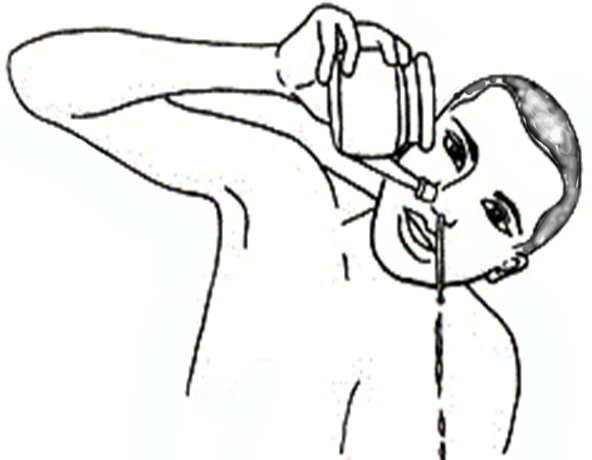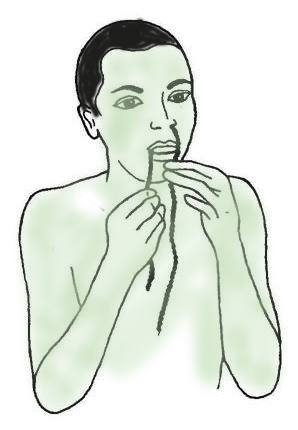In Hatha yoga, Neti Kriya is one of the six particular practices which were specifically designed to bring and maintain a balance between vata, pitta and kapha (tridoshas). They are called shatkarma. Shat is six, karma is action. These techniques regulate the production of the doshas. Hatha yoga is famous for these six cleansing techniques. Although only six in number, each has a variety of practices.
Navigator
Shatkarmas
-
Dhauti
1. Antar Dhauti
i) Vatsara
ii) Varisara(shankhprakshalana)
iii) Agnisar
iv) Bahishkrita (ractal cleaning)
2. Danta Dhauti
i) Jihva mool
ii) Dant mool
iii) Karna randhra
iv) Kapal randhra
3. Hrid Dhauti
i) Vastra Dhauti
ii) Danda Dhauti
iii) Vaman Dhauti
4. Moola shodhana
-
Basti
i) Jala basti
ii) Sthala basti
-
Neti
i) Sutra neti
ii) Jala neti
-
Trataka
i) Antaranaga
ii) Bahiranga
-
Nauli
i) Dakshina nauli
ii) Vama nauli
iii) Madhyama nauli
-
Kaplabhati
i) Vatkarma
ii) Vyutkarma
iii) Sheetkarma
Jala Neti
Neti is a cleansing practice that cleanses your nasal passage. It is basically of two types, Sutra Neti and Jala Neti. Jala neti is the process of nasal cleansing with water. For jala neti practice a special neti lota or pot is required which has nozzle specifically designed to fit into the nostril. The neti pot should be filled with warm saline water, the salt should be just enough to taste.
Step by step process to practice jala neti
- Stand straight with legs apart, body weight evenly distributed between the two feet and lean forward.
- Tilt the head to the right side and place the pot’s nozzle in the left nostril.
- Open the mouth slightly and breathe through the mouth.
- Pour the water into the left nostril through the nozzle slowly and it will come out through the right nostril.
- Keep breathing through the mouth calmly. Do not get feared, the water will come automatically from the opposite nostril.

- Keep the whole body relaxed and let the water pass out through the right nostril.
- When half of the water is used, remove the pot or lota, remain to bend forward, center the head, let the water run out of the nose.
- Close the right nostril with the fingers and blow gently through the left nostril so that all remaining water comes out. Now close the left nostril and blow gently through the right nostril.
- Practice in the same way passing the water through the right nostril.
- After completing the practice do Kapalabhati for 10-15 rounds.
- Then adopt shashankasana for some time.
Precautions (Jala Neti)
- Never practiced with the cold water.
- A proper amount of salt must be mixed in the water, neither too little nor too much.
- If you experience pain in the nose while practicing, the quantity of salt is incorrect.
If you feel heaviness and pain in the head, the quantity of salt is incorrect or the water is not warm enough.
Sutra Neti
Sutra means ‘thread’, earlier people used to practice neti direct from sutra but nowadays a catheter is being used a prior practice to sutra neti. In therapeutic setups, the person is first made to practice ‘rubber (catheter) neti’ as a prior practice to sutra neti. The method of practicing sutra-neti or rubber-neti is explained here:
How to practice sutra neti?
- It can be practiced both in the sitting and standing posture.
- Squat on your heels or stand straight, tilt the head slightly back and insert the thread or catheter straight into the left nostril.

- The thread should not be forced through the nose but gently pushed so that it slowly passes down into the throat without any harm in the passage.
- When it reaches back of the throat, put the first two fingers into the mouth and pull the thread out through the mouth leaving a few inches of thread hanging out of the nose.
- Slowly and gently pull the catheter backward and forwards five to ten times (some suggest to move it for about twenty to forty times).
- Pull the catheter or sutra out very slowly and gently through the mouth and wash out your mouth and nose.
- Then repeat the practice in the same manner from the opposite nostril.
- It must be practiced from both the nostrils one after the other.
- After completing sutra neti practice jala neti once again.
- After completing the whole procedure practice Kapalabhati 10-15 rounds.
- Then adopt shashankasana for some time.
- This is the practice of sutra neti.
Important:
- If some drops of blood come through the mouth then no need to worry it simply means that a small scratch has happened somewhere in the nasal passage or in the deep throat because of the rubbing of sutra. That is why it is advised that the sutra or catheter must be rubbed very slowly and gently.
What are the benefits of neti practice (jala neti and sutra neti)?
- Cleanses the nasal passages.
- Cures sinusitis.
- Removes the impurities in the sinus cavities.
- Useful in ENT disorders.
- Reduces the headache.
- Increases the eyesight.
- Brings shine on the face.
- Reduces stress and anxiety.
- Useful in various mental problems.
Important:
The above-explained practices are highly sensitive. These practices must be performed under the guidance of a good yoga teacher or therapist. For beginners, it is suggested that consult a yoga therapist or a teacher and start practicing also become sure about the consequences of neti practice with respect to your health.
These are the general benefits of neti practice but it differs from individual to individual according to the severity of the problem.

